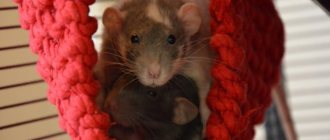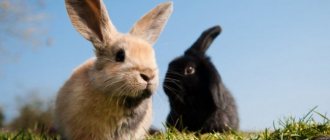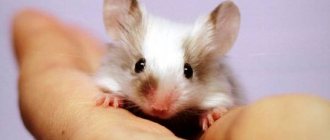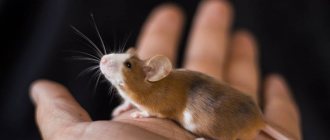- home
- Chinchilla
- Health
04/03/2019 Breeding chinchillas is a promising business that, with a skillful approach, can bring good income. Today, many people want to have this cute fluffy at home; pet stores do not refuse to take chinchillas for sale. There are two options - breeding for skins and meat and as pets. This article will be useful in both cases.
When does puberty occur?
Female chinchillas reach sexual maturity at eight months of age, males several months earlier. In both individuals, sexual activity lasts about 12 years. In nature, the mating season for chinchillas lasts from March to November.
Animals reproduce at home with proper feeding, a dry climate, and an air temperature of at least +20℃. In one year, a female rodent can give birth 2-3 times from one to five puppies, but no more than twice a year. Chinchillas begin to mate after three to four months of living together, and have offspring almost a year later. Pregnancy of a small rodent lasts up to 3.5 months.
Signs of estrus in a female
Male behavior
A clue that the female is in heat can be indicated by the characteristic behavior of the male: the animal is actively interested in and cares for the female, makes loud mating sounds, twitches its bushy tail, bites the female’s fur and often makes attempts to jump on the female for mating.
Inspection of the female's loop
The female genitals swell and open, acquire a pink color, white discharge from the loop is observed, and the female's nipples become long and red.
Matching
The time for mating of rodents is selected taking into account the age of the female and male. Sexual maturity in females begins at six months of age. For a female of this age, the partner must be three months older. And for an individual older than a year, it is better that the male is several months smaller. But this is not the main thing in choosing a couple. Important conditions in choosing partners for mating:
- it is necessary to have the same breeding characteristics;
- be from a purebred breed with good genetics;
- have good health;
- have fur of the same color and quality;
- do not create related pairs until the third generation.
Fat or very thin animals are not mated to produce viable offspring. The rodents are placed in separate cages and their behavior is monitored. Then a male is placed in the female’s cage. If the animals’ behavior is not aggressive, then the transplantation was successful. There are times when chinchillas begin to conflict, then it is better not to mate them. Female rodents are often more aggressive than males. It is easier to create a pair of young animals, since they quickly get used to each other and by the time of puberty they are already ready to produce offspring.
The minimum estrus cycle for a female is 20 days
Character, behavior and habits
Each animal has its own character, but there are features that unite this species. All animals are very inquisitive. They will not ignore changes in the environment and new things in the cage. They react violently to the arrival of guests and find a favorite among family members.
Shushi are nocturnal animals; they like to sleep during the day. Watching them sleep is very funny. Everyone has their own preferences: some sleep on their sides, others curl up in a ring or take another “uncomfortable” position. Usually the animal wakes up at 7-8 pm, and its peak activity occurs at 10 pm.
Chinchillas make very interesting sounds. Each sound has its own meaning, and with their help you can understand how the animal feels. Lonely shushis often make searching sounds. This is how they try to find their relatives. A male paired with a female often sings a mating song and performs a dance, twirling his tail.
When the animal gets angry, it begins to click its teeth and make a cracking sound. If her displeasure is caused by a person or another chinchilla, she may attack the offender. Their attacks are quite funny: the snarling rodent stands on its hind legs, stretches out, releases a stream of urine and tries to bite. Their bites are harmless. Despite the fact that they have sharp and long teeth, they are not able to bite through the skin.
Relationships with rodents and other animals are usually complex. Shuni do not pay attention to other animals as long as they are not touched. But as soon as a cat or dog becomes interested in the animal, he will begin to experience severe stress. If you want to keep a chinchilla in a house where there are already pets, give it a separate room.
How chinchillas mate at home
In captivity, chinchillas mate best from November to May. When chinchillas are ready to reproduce, they dramatically change their habits. The male wags his tail, runs after the female, and makes snorting sounds. The female behaves differently, she:
- shows anxiety;
- loses appetite;
- scatters food around the cage.
Animals mate during the female's estrus. Estrus occurs after 1-1.5 months. Sometimes, due to the peculiarities of the chinchilla’s body, the minimum cycle is 20 days, and the maximum is 60 days.
Birth of a new life
Chinchillas usually give birth in the first half of the day. Most often, the female does not need anyone's help. Babies are born quickly. They are already covered with fur, their eyes are open, and their mouths have a full set of teeth.
After giving birth, the mother eats the placenta. It contains all the beneficial substances necessary for the chinchilla's body during breastfeeding.
It is simply impossible to hold a chinchilla in your hands, play with it for at least a couple of minutes and not fall in love with this exotic rodent. They are ideal pets, the best furry friends for children.
And if, after reading about all the benefits of keeping these animals, you have not yet made a decision, go to the pet store right now and look into the little black eyes. The answer will come by itself!
Crossing chinchillas
Features of crossing the main breeds
Chinchilla hybridization has its own rules. It is not recommended to crossbreed two black velvet chinchillas, as they may not produce offspring .
- If crossed with Wilson white, you will get snow-white velvet. Wilson's beige produces white, silver, mosaic individuals. The Wilson breed also has a lethal gene. Therefore, crossing these two breeds is not recommended. Suitable for crossing beige chinchillas. If they are crossed with individuals of black velvet color, they will get brown velvet, and with Wilson's snow white, they will get a white-pink color.
- To obtain a smoky or chocolate color, they are crossed with a chinchilla - a carrier of the ebony gene. As a result of the hybridization of two homobeige, heterobeige or hetero- and homobeige chinchillas, homobeige animals are obtained. If homobeige animals are crossed with ordinary individuals, then heterobeige animals are born.
- When crossing a brown velvet rodent with an ebony rodent, the color velvet pastel is obtained.
Crossbreeding of non-mainstream breeds
- The fur of the snow-white ebony chinchilla breed is colored white and black. To get such an individual, white heteroebony and homoebony are crossed. Mixing white flowers with rodents is not recommended due to the deadly gene.
- Chinchillas, painted in velvet pastel color, have a bronze back and brick-colored eyes. This color is obtained by hybridizing pastel with brown velvet or velvet ebony. With such selection, the likelihood of obtaining chinchillas with a chocolate-velvet tint of fur increases.
- Homoebony fur is considered interesting - it is very rare to come across a perfectly black color. Hybridization produces homobeige, chocolate brown, and lilac fur.
- Heteroebony breed better than homoebony. The coat color varies from light to dark. This color is obtained after hybridization of homoebony and gray chinchilla.
There are several barriers to breeding
Where did they come from
The homeland of chinchillas is the mountain ranges of South America. There they settle in caves and burrows, appearing outside only at nightfall.
According to legend, the rodents got their name from the name of the Chinchil tribe of Indians, who were dressed in soft and fluffy fur. It was because of their stunning fur coats that the animals were practically exterminated.
Hunters were interested not only in skins. There is fragmentary information that chinchilla meat was used in the treatment of tuberculosis.
Chinchilla hunting did not stop with the disappearance of the Chinchil Indians. The Spanish conquistadors, having entered South American soil in the 16th century, were fascinated by the fur of these animals. Fur coats, coats, and collars were a huge success, and thousands of chinchillas were caught to meet demand. The barbaric extermination of the species continued for several hundred years.
Ultimately, rodents fell into the category of rare, endangered animals. Now they are listed in the Red Book and are protected by law.
Frequently asked questions about chinchilla breeding
When purchasing chinchillas for breeding and sale, various questions arise.
Why chinchillas don’t reproduce - the main reasons for refusing to mate
Reasons for refusal to mate may be:
- inappropriate age of the couple;
- weak or sick animal;
- improper conditions of care and maintenance;
- individual qualities.
At what age are chinchilla babies ready to “say goodbye to mommy”?
Chinchilla cubs weigh on average 30-75 grams, require mother's milk and continue to eat it for another two months. Small chinchillas are allowed to be separated from an adult female when the weight of the babies reaches 200-260 grams.
Can relatives of chinchillas mate?
To exclude sick and weak offspring with birth defects, it is not recommended to mate chinchilla relatives.
How to make friends with a future chinchilla pair before mating?
Before placing one animal with another, it is recommended:
- choose a cage with a height of less than one meter and a width of 75 cm;
- thoroughly wash the enclosure before adding the chinchillas;
- remove all foreign objects from the cage so that the animals are not injured during a possible fight;
- build a maze of boxes so that the male can escape if the female shows aggression;
- roll the female in sand with the male's feces, and place the male rodent in the female's uncleaned cage;
- first place the male in his cage, and place the female next to him;
- the owner of the animals must observe the behavior of the couple for four hours. If chinchillas begin to show aggression or fight, they are immediately isolated and given medical care;
- to distract rodents from the conflict, it is necessary to add coarse hay to the enclosure - it will distract them from rude behavior;
- You will have to observe the behavior of the animals until the end of the day;
- It is recommended to feed the couple with high-quality food that includes fresh fruits, useful microelements, and various vitamin supplements;
- wait patiently until your beloved pets prepare to reproduce;
- if mating has not occurred for a long time, start looking for another partner.
Can chinchillas have same-sex relationships?
Two chinchillas of the same sex can easily live their entire lives, especially if they are from the same litter or raised together in the same cage.
Chinchillas have unique hair follicles
Business idea for breeding chinchillas
Chinchilla fur is a valuable material that is used in the fur industry to make outerwear. The uniqueness of the fur is that more than eighty villi grow from the hair follicle. The skin of this valuable animal does not shed at any time of the year and is always in excellent condition. Breeding chinchillas is profitable. Such skin costs 250 more than rabbit skin. The business of breeding chinchillas at home is available to everyone. Chinchillas:
- do not take up much space;
- do not have an unpleasant odor;
- eat plant foods;
- have valuable fur and dietary meat;
- unpretentious in care.
This kind of business is within the reach of anyone, the main thing is to comply with sanitary and hygienic standards for caring for rodents.
Do you already have experience in breeding animals?
How much does it cost to start a business?
No licenses or permits are required to organize a business. It is enough to register as an individual entrepreneur or farm and register with the veterinary service.
Risks and payback
To run a successful business, it is better to immediately calculate all the money spent and the expected amount of income. Anticipated risks include:
- improper care and nutrition of animals;
- chinchilla disease.
The benefits of mass breeding of chinchillas are confirmed by the following arguments:
- there is no competition;
- there is a demand for the fur of a valuable animal;
- high profitability;
- People without special education can engage in such business.
At the initial stage, breeding chinchillas will not require large financial costs.
Important points of a business plan for breeding chinchillas on an industrial scale
It is better to start your business with small volumes that do not require large financial costs.
What equipment will be needed?
When starting your own business, it is enough to purchase several cages adapted for breeding a small number of chinchillas. In the future, when production moves to an industrial scale, a complete set of equipment will be required:
- enclosures for keeping animals;
- bunker feeders;
- automatic drinkers;
- hygiene devices;
- air conditioners and electric heater to maintain a constant temperature not lower than +18℃ and not higher than +20℃
The room area is chosen to be 20 m2 in size to accommodate 100 chinchillas. Requirements for keeping chinchillas in a large room:
- absence of drafts;
- air humidity from 50-60%;
- lighting with electric lamps;
- detached building.
Purchase and selection of breeding stock
For successful breeding, young chinchillas are selected. It is better to take them from special nurseries that improve the gene pool of valuable animals. Selected males are expensive, but their payback will exceed the costs, because their ability to reproduce offspring remains for 10-14 years.
Feeding chinchillas
Feeding is an important step in the selection of healthy chinchillas. Food is usually purchased ready-made or prepared independently from cereal crops that rodents like. They love hay and dry dandelion leaves. In summer it is recommended to feed fresh grass, and in winter add apples and carrots to the diet.
Mini-farm registration
Registration of an individual entrepreneur with the Federal Tax Service begins when the subsidiary plot begins to generate the first profit.
The entrepreneur chooses the Unified Agricultural Tax with a 6% rate. Must be registered with the veterinary service. For a chinchilla breeding business you will need two documents:
- ownership of the enterprise;
- certificate of registration in the veterinary service.
Sales organization
To successfully sell fur-bearing animals, you will need knowledge of sales markets. One of the main ways to promote products is advertising. For this we use:
- Internet (creating a personal website, a group on social networks to communicate with participants and attract new customers);
- visual advertising (flyers, brochures, big boards);
- search for wholesale buyers.
Products are sold in several ways:
- breeding animals are left for breeding, and the remainder is sold;
- sell products unsuitable for breeding and obtaining high-quality fur raw materials as pets;
- They sell chinchillas to a workshop for sewing expensive fur products.
Furry namesakes
The amazingly beautiful fur of these small fluffy rodents captivates everyone who has ever picked them up. All thanks to the unique structure of the hairline. About 70 hairs grow from each bulb located on the skin of an animal. The wool is so thick that not a single insect is able to settle in it.
This unique fact has fascinated even cat lovers. About twenty years ago, the silver chinchilla breed was developed as a variety of short-haired British cats.
The namesakes of our cute rodents are extraordinarily beautiful. Cats have white fur, with slight blackening at the tips, and the head, tips of the paws, side, back and tail of the animal are covered with a black veil. Among their feline counterparts, they stand out for their truly royal appearance.
In addition, the British chinchilla has an unusually kind and flexible character. Such cats cope well with their own loneliness. And if necessary, they can become an excellent “interlocutor” for their owner. Each “meow” uttered by these cats is endowed with special intonations and deep meaning.
Everyone who has at least once gotten to know these cats better has fallen in love with them once and for all. Every year, an increasing number of fans are attracted to this amazing cat breed.
Just a couple of minutes alone with a Briton - and everyone will confidently say: this is an amazing cat breed.











